Alan Gross: A Profile in Art and Courage
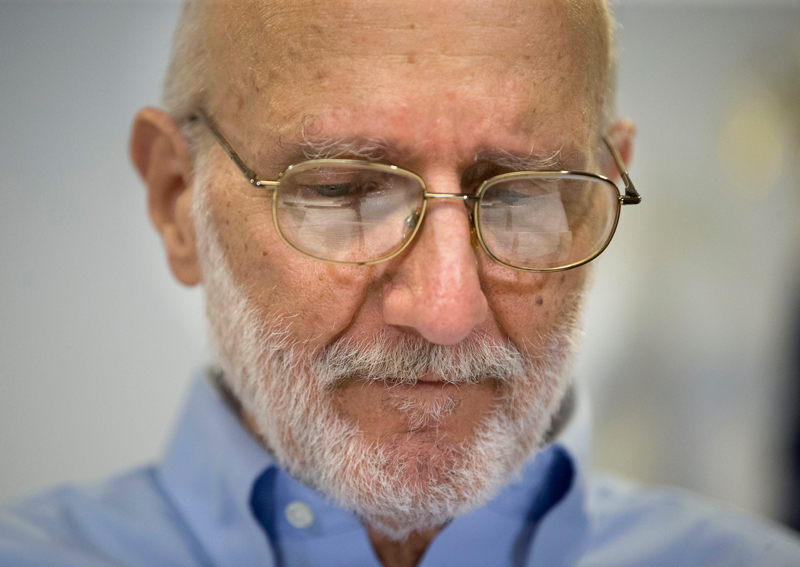
Prison Artwork by Alan Gross
Interview by Nadine Epstein
After five years as a prisoner in Cuba, Alan Gross was released on December 17 as part of a deal aimed at improving U.S.-Cuba relations. The Washington, DC resident and former USAID subcontractor was arrested in 2009 for bringing computer and networking equipment to Cuba’s Jewish community. Two years later, he was convicted of being “a threat to the security and integrity of the state,” and sentenced to 15 years. As a prisoner, Gross lived his life in the confines of a small cell, fighting anger, boredom and declining health. Four years into his stay, he was given a computer as part of a quid-pro-quo deal between the United States and Cuba. Gross had never drawn and didn’t consider himself an artist, but to pass the time, he began playing with the only two programs on the computer: Microsoft PowerPoint and Paint, both in Spanish, which he didn’t know but was trying to learn. There was one more item on the computer: a scanned copy of an Argentine Spanish language instruction booklet from which he clipped images that he modified and incorporated into computer creations. Using these limited components, Gross made more than 2,000 pieces of digital art, documenting his life and recording his feelings in a unique visual style. In this exclusive interview, Gross—who is, of course, thrilled to be home—reveals the stories behind eight of the pieces he created while in prison.
Finlay 1
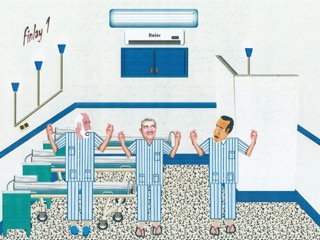
“You can see that in this image of the three men wearing striped pajamas, it says Finlay on the wall. I spent most of my time in a cell in the prison annex of the Carlos J. Finlay Military Hospital campus in Havana. The walls of my cell are painted white here, but it was really more of a gray-white. The floor is terrazzo, common in Cuba, at least in Finlay. The three beds were manufactured in East Germany in the 1960s. The room looks a lot better in the picture than it did in real life.
I had a total of 20 cellmates, two at a time. In the last year there were two—Joel is the dark-haired one, and Alejandro is the light-shaired one. In this image we are standing with our hands raised, gesturing ‘What the heck?’ or ‘¿Que paso?’ It may look like we were exercising but we weren’t. We were allowed to go to an exercise yard once a day. It was an extremely small space with very high walls. The ceiling was open except for steel bars crisscrossing. Sun could come in, but very little.
Usually I walked and did pull-ups. Joel would do push-ups and stretching, and Alejandro would walk and do modified tai chi. And we invented games. You know the roller ball in deodorant? The ball looks like a ping-pong ball, and when the deodorant was empty, we would take the ball out. We had three or four balls, and we would make up games with them.”
Villa Marista
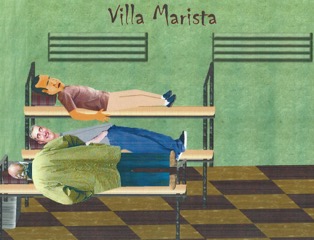
“I only stayed in two places during my imprisonment, Finlay, and, for a total of about six weeks, in Villa Marista. Villa Marista is a jail in a police station. If you look at this image, that is about the size of the room. You can see the relationship between bodies and cots, and that’s pretty close to reality. Those slots are in lieu of windows. They are air vents. We never knew if it was day or night.
We were there one or two weeks at a time. When they were doing work at Finlay they transferred us to Villa Marista. Whatever reason they gave us, it was a lie. It was all lies. I didn’t believe anything they said.
Villa Marista is about a 15-minute drive from Finlay. They would take my cellmates separately from me. They would put me in a car, and a five-car motorcade with 20 guys escorted me to Villa Marista. As if I were Frank Sinatra and they were my bodyguards. They made a big show, had police block intersections so we could go through. It was all, frankly, bullshit.”
Hay No Mucho Tiempo

“This was my corner of the room of the cell that we were in during the last year and a half. 243444 was my identification number as a prisoner, and I put it on my arm as if it were an Auschwitz tattoo. I usually wore only the striped pajamas that you see in the Finlay picture. The only time we were allowed to wear real clothes is when we had a visitor.
Sometimes my hip bothered me a lot, but I really didn’t use the cane. But I did smoke Cuban cigars. They were great! I bought them. Once a month I had a visit from the U.S. Consulate Interest Section in Cuba. I had my money in an account there, and they would use it to buy vegetables, cigars and things like that for me. My family would send packages, but they would take six months to arrive. Sometimes a State Department official traveling between Cuba and the United States would bring canned salmon, deodorant or toothpaste.
On the table next to the cigar you can see a humidor I made out of a Ziploc box to keep tobacco moist. My wife Judy sent me chocolate chip cookies in that Ziploc box. We don’t throw anything away in Cuba, we reuse it for something, and after we consumed the cookies, I put in cedar wood from the tobacco box and made a humidor. I would moisten the cedar wood every day and it would keep the cigars humidified.
One of the people from the U.S. Consulate Interest Section brought me the hat I am wearing. It has an ‘I’ on it, which stands for Industriales, a local Cuban baseball team. I was a fanatic, a fan. I watched them play on television. After the first year we were given a television, and a year and a half before I was released, a flat screen television. Actually we had three of them, the first two burned out. They were from China. Not much, if anything, is Cuban-made.
Hay no mucho tiempo means ‘There is not much time.’ I didn’t have all the time in the world and the Cuban government didn’t have all the time in the world, either, and I made this because I wanted to make sure that they realized it. This was not a secret document and if they didn’t get the message, they were pretty dumb. They saw everything. I gave a copy to the U.S. Interest Section, too. I was serious about it and I wanted to make sure the Cubans realized that. I’d still be sitting there if they hadn’t.”
Pollo & Bagels Y Lox
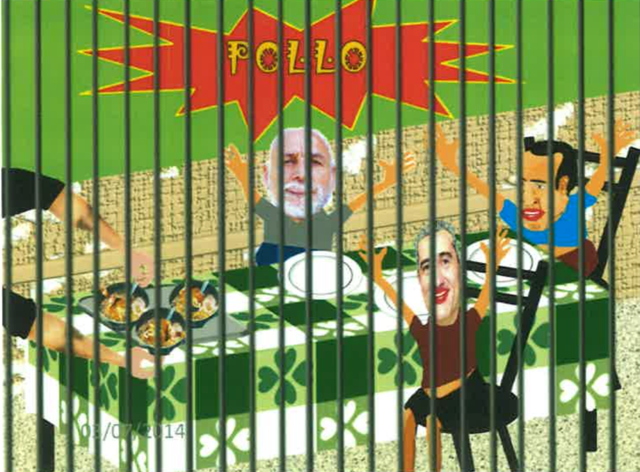

“We always had ‘carry out.’ Meals were brought into the room, and pretty much every day we had chicken. Early on, all the food had bugs in it. That’s how I started my ‘putrid system diet’: I had a policy that if it moved I wouldn’t eat it. The food eventually got better, but it was still chicken. My cellmates and I would always wonder what we were going to have for a particular meal and whenever they served chicken, we would say ‘pollo’ as if it were a surprise. It was a sarcastic joke. And as you can see I thought about bagels and lox a lot. I thought about traditional Sunday morning Jewish brunches. That was one of the first things I had when I got home.”
“I’m infected with Cuba. I love the people, and when the government of Cuba loves its people, too, everything will be fine.“
Prisionero de Dos Gobiernos
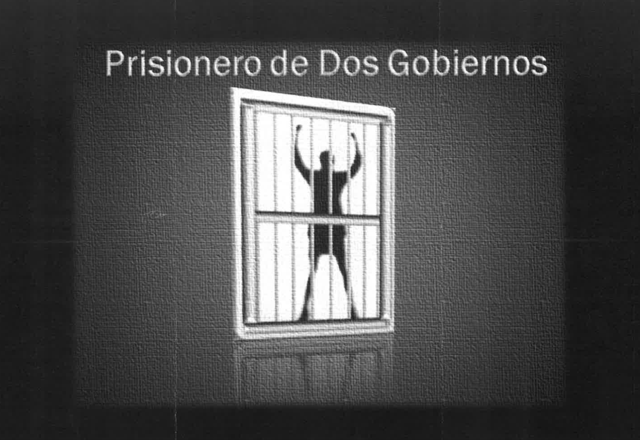
“This means prisoner of two governments, which is exactly what I was. As you see, I wasn’t always a happy-go-lucky guy there. Things were not always peaches and cream. I could express things in humorous terms, but Prisionero de Dos Gobiernos is not humorous. In it, the person holding up his arms is a Microsoft image but I made the rest of it. I made the window and its shadow and the texture of the walls in PowerPoint.
PowerPoint is a great program with all sorts of good tools. I could do a commercial for PowerPoint. When you don’t have anything to work with, you have to work with what you have. I have never been artistically talented. What I have been able to do is express some ideas with tools that allowed me to make things that I could not do without computer assistance. This opened up a whole new world for me.”
Happy 44th Anniversary

“I made this for Judy in July 2014, since our anniversary is July 19. Both my face and Judy’s face came out of the Argentine language booklet. It was an edited image of a woman from Mexico. When I saw it, it looked like her, so I just changed the hair so it looked more like her. My face is that of a man from Argentina who was on the same page. I made the bodies, and the clothing and shoes.
In ‘Or maybe we will stay in DC…,’ I created the wall and the fireplace. The rug I modified. All the things on the bookcase are either made or modified. One of my cellmates made the jar of low-fat Skippy peanut butter on the right shelf. I had received the jar from home. On one shelf there is a box of matzah. I made that as well as the candlesticks on the fireplace mantel next to the Siddur. The Siddur is modeled on the Siddur that my sister’s rabbi, Stefan Weinberg, sent me from Anshei Torah Synagogue in Plano, Texas.
The beach is a Microsoft Windows image, the Eiffel Tower and building came from the Argentine Spanish booklet, as did the city scene on the right bottom, which is too nice to be Cuban. Not that there aren’t nice sections of Cuba, but where I was, nothing like that existed.”
Hasta la Vista!
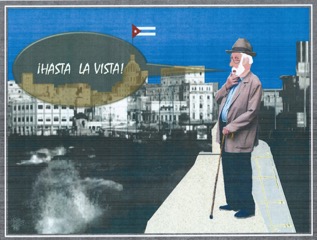
“Hasta la vista means ‘Until I see you again.’ The scene is the Malecón in Havana. It’s a famous area that spans the perimeter of Havana. I am standing on the Malecón seawall. In the background is Havana. It is a picture of the Malecón that I modified, it’s from that same stupid Spanish instruction booklet. It had famous images of Latin America so I mined what I could.
I made this when I knew I was going to leave Cuba. When I knew, I started thinking about when I would be able to come back. I was an unintentional catalyst for all of the changes that are taking place, now I wanted to be intentional. I had things to say that I hoped would be helpful. I was thinking this then, and am thinking it now. I’m infected with Cuba. I love the people, and when the government of Cuba loves its people, too, everything will be fine.
The future could be negative or positive, it all depends on Cuba. All the pressure is on them to do the right thing. They don’t need to reciprocate with the United States, they need to reciprocate with the people of Cuba. I wouldn’t go back unless they promised they wouldn’t arrest me again. But I would go back in a heartbeat.”



6 thoughts on “Alan Gross: A Profile in Art and Courage”
We completely loved your manuscript and how smart you were to be able to use power point to produce this story. We think you should think hard about ever returning to Cuba, as much as you love the people.
So glad you are back in the US, and this is where you should stay!
Love, Renee and Ron
Its articles like this that make me want to renew my subscription to Moment Magazine. welcome home.
My thanks to Nadine Epstein for getting the story right!
What a wonderful surprise to see Alan’s creative work. May the best be yet to come for you and family.
Dear Alan,
You spell your name the same as my husband Alan, so already I like you! Your portrayal of life in Cuban’s prison system is very creative. Learning it all on the computer is even better. Kudos to you & your wife for keeping the faith.
Shalom-shalom,
ellensue jacobson